
Classroom Chaos to Orchestrated Learning: How Tech Can Help Teachers Manage Tablets in the Classroom
"Discover how a new software framework, Chao, is empowering teachers to effectively manage tablet-based learning activities, turning potential classroom chaos into structured educational experiences."
Imagine a classroom buzzing with the energy of students using tablets for learning. While the potential for engaging and interactive education is immense, the reality can often be overwhelming for teachers. Managing multiple students, each working at their own pace and potentially encountering different challenges, can feel like conducting an orchestra without a score. This is where the concept of 'orchestration technologies' comes into play – systems designed to support teachers in managing technology-enhanced learning environments.
Traditional approaches to integrating technology in the classroom often fall into two traps: either creating highly specific systems that are difficult to adapt to different learning scenarios or adopting generic 'one-size-fits-all' solutions that fail to address the unique needs of individual classrooms and students. What's needed is a flexible, adaptable framework that empowers teachers to tailor technology to their specific pedagogical goals.
The research introduces Chao, a novel software framework designed to bridge this gap. Chao provides computer scientists and educators with the foundational tools to develop tablet applications that actively support teachers in orchestrating learning activities. By understanding how teachers manage classrooms and the types of information they need, Chao offers a pathway to creating more effective and manageable technology-enhanced learning experiences.
What is Classroom Orchestration and Why Does it Matter?

Classroom orchestration, at its core, is about how a teacher manages multi-layered activities in real-time while navigating various constraints. Think of it as the art of conducting a classroom, where the teacher balances individual student needs with the overall learning objectives. This involves everything from assigning tasks and assessing student progress to providing explanations and adapting the lesson on the fly.
- Supports teachers' leadership: Teachers retain control over classroom activities, ensuring technology serves their pedagogical goals.
- Embraces the Physical Dimension: Recognizes the importance of physical interaction and movement in the classroom.
- Flexibility is Key: Allows teachers to adapt learning scenarios on the fly, responding to the evolving needs of their students.
- Minimalistic Design: Reduces the cognitive load on teachers, making the technology easy to use and integrate into their existing practices.
The Future of Orchestrated Learning
The Chao framework represents a significant step towards creating more effective and manageable technology-enhanced learning environments. By providing a flexible and adaptable foundation for developing orchestration technologies, Chao empowers teachers to harness the power of tablets without being overwhelmed by the challenges of classroom management. As technology continues to evolve, frameworks like Chao will be essential in ensuring that it serves as a tool to enhance, not hinder, the learning process. The key takeaway is that the more complex the monitoring data is, the more code lines are necessary to instantiate the framework.
